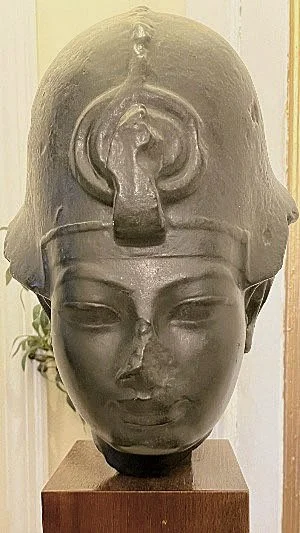Meeting Pharaoh at the Market
It was hard not to notice him. His beautiful eyes - I always notice a man’s eyes - stared at me through the crowd. His stare was strong, but also serene, majestic. I am shy by nature and only allowed myself momentary glimpses of this handsome man looking at me.
After over a decade of living in New York, it was my first time at the Chelsea Flea market. I wasn’t sure what to expect, but I wasn’t expecting to find him there. I have the terrible habit of talking myself out of what I really want to do, so I just told myself it couldn’t be for me. So, I continued winding my way through the various sellers’ tables piled high with vintage clothes, old silver, and someone’s forgotten tchotchkes of a bygone era. I loved it, as a connoisseur of tchotchkes myself. But amongst all of this, I could still feel him looking at me.
This meeting felt fated then in this place (an empty lot on 25th Street between 5th and 6th Avenue, a minor miracle in Manhattan these days!) filled with pieces of everyday history, every object having a story of its own. As I weaved my way between people, I kept catching glimpses of him. I purposefully walked past him a couple of times just pretending to peruse to get a better look. Finally, I mustered up the courage to go over there.
As I approached, I was shocked that others didn’t notice him. Finally, we were face to face. I picked him up so I could look deep into his eyes. Elegantly arched eyebrows, full lips, and wearing the khepresh crown, the war crown, of ancient Egypt with the uraeus cobra on the front. He was simply gorgeous. A replica of an unknown (at that moment) pharaoh’s head, attached to a simple wooden stand. To me, this was the ultimate flea market find.
I brought him over to the seller and asked how much. Before I even had a chance to consider the price and haggle, he said “$50, no $40, okay $30!” I was ready to say yes at $50 but left feeling like a bargain-hunting champion, even though I hadn’t actually done any haggling.
I stuck pharaoh under my arm, and thank God I have long arms because this guy isn’t small. I schlepped him around Madison Square Park, even stopping in at PetSmart to pick up a few things for my little dog. In the store and walking down 23rd Street people stared at me carrying this odd-looking statue. Finally felt like the New York City eccentric I always aspired to be.
Thankfully, I got a seat on the subway, my arms were so tired, but now the real fun began. I wanted to know who the hell this guy was. I love nothing more than solving a little history mystery. I began Googling and scrolling through images. I had a sneaking suspicion this was a replica of an actual museum piece. Eureka! I found a similar-looking bust in the collection of the Metropolitan Museum of Art of a little-known pharaoh named Amenmesse. I arrived home feeling satisfied, and I left it at that.
But Pharaoh was not pleased. His stare had become colder. I knew I had misidentified him.
So, back to Googling. This time I really took my time and used those history research skills. Then I found him. Those same eyes stared back at me from the screen that now kept watch in my living room. I was living with Amenhotep III, one of Egypt’s greatest pharaohs of the 18th Dynasty. My Amenhotep was a replica of the original at the Louvre. Now I felt extra fancy, a big-time pharaoh from the Louvre!
And Amenhotep III was a big deal. Ruling at the height of Egypt’s New Kingdom. He was the most powerful man in the world for nearly 40 years, ruling a vast empire stretching from Syria down to modern-day Sudan. Lavish palaces, temples, and mountains of gold. This was the zenith of ancient Egypt. Probably the most recognizable monument that remains of Amenhotep III is the Colossi of Memnon, giant statues that once guarded the entrances of Amenhotep’s enormous mortuary temple.
However, Egypt’s golden age, as any perceived golden age, cannot last forever. His son, Amenhotep IV, would become better known as the heretic pharaoh, Akhenaten. Akhenaten’s nearly 20-year reign would destabilize Egypt as he pursued quite possibly, but still fiercely debated among Egyptologists, the first manifestation of monotheism. Akhenaten and his famous queen Nefertiti (strangely I have a replica of her bust as well, that I got in Romania, but that’s another story) would force Egypt to worship only the sun disk, the Aten.
In the end, it would be Amenhotep’s grandson, Akhenaten’s son, that would outshine them all. Not because of his achievements, but because he accomplished what every pharaoh did their absolute best to avoid, he was forgotten. Forgotten just long enough until his tomb was discovered in November 1922 by Howard Carter, revealing the greatest stash of ancient Egyptian treasures to ever be found, the boy-king Tutankhamun. So, all in all, it was a good day at the flea market.
